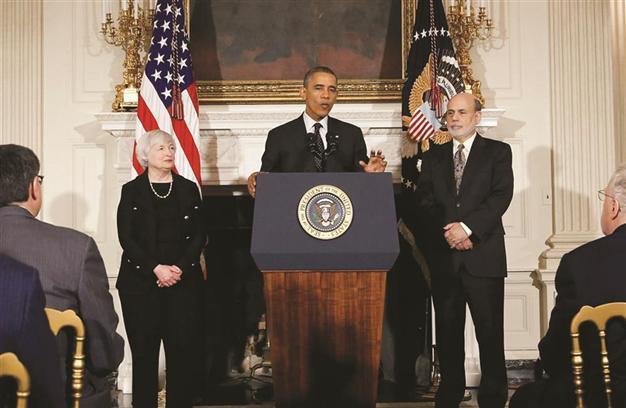Fed expected to hold tight on stimulus after gov’t shutdown
WASHINGTON - Agence France-Presse

US President Obama (C) announces his nomination of Yellen (L) to head the Fed at the White House on Oct 9. The damage of idling hundreds of thousands of federal workers due to government shutdown cost the economy $25 billion, analysts say. REUTERS photo
Skewed data and the economic setback of the partial government shutdown face Federal Reserve policymakers as they review their economic stimulus program tomorrow and Oct. 30.
The broad consensus is that, in their first meeting with Janet Yellen as the official heir-apparent to chairman Ben Bernanke, the Federal Open Market Committee will opt again to wait for more evidence of economic strength.
That will prolong the guessing game of when the “taper” of QE3, the Fed’s $85 billion-a-month bond-buying stimulus program, will begin.
But Bernanke, and his close ally Yellen, have stiffly refused to bow to market expectations, pledging to act only when economic data supports it.
The FOMC stunned markets in September when it decided not to begin reeling in the centerpiece of its efforts to boost US growth.
Guided by Bernanke’s own signals, most analysts and investors had expected for months that the drawdown of the quantitative easing program was coming then, and stocks had fallen while bond yields pushed up sharply.
The markets then reversed on the FOMC’s narrow September 18 decision, with stocks soaring to new records on the prospect of the easy-money spigot staying open and keeping interest rates low.
In a show of prescience then, Bernanke said they were worried about a possible government shutdown and a US default on its obligations due to the building fight in Congress over raising the debt ceiling and passing a budget for fiscal 2014.
No deal in the beginning of new fiscal yearAs it turned out, on October 1, the first day of the fiscal year, there was no agreement and the government shut down partially for 16 days.
It reopened only after a short-term budget was agreed and the debt ceiling was lifted, barely averting a default. Analysts said the damage of idling hundreds of thousands of federal workers cost the economy $25 billion and lopped up to 0.5 percentage points from fourth quarter growth.
Also damaged was the data flow: collection and release of information that could tell the Fed how the economy is doing was interrupted and delayed. In the October 29-30 meeting, markets will be surprised if the Fed does begin reducing the stimulus. Most analysts expect the taper will be held off until next year, which would mean only when Yellen takes the helm -- pending her confirmation in the US Senate.
The data that has come so far shows a dull economy: trade was flat in September; durable goods orders, excepting aircraft, were slightly down; job creation in September was tepid; and the University of Michigan consumer sentiment reading fell on Friday to its lowest level since January amid a surge in pessimism.
And the Fed’s own Beige Book survey of regional economies showed slower growth in a number of areas.
With all signs showing low impetus for businesses to invest and hire, Charles Evans, an FOMC member and president of the Chicago branch of the Fed, suggested on October 17 that reeling in the stimulus was not in the cards this month. “It is not yet time to remove accommodation. The data are still not definitive enough to say that now is time to adjust the QE3 flow purchase rate.” The data, especially on jobs market progress, will be questionable through December, said Ian Shepherdson at Pantheon Macroeconomics.
“Even if the data take a clear and unambiguous turn for the better in December and beyond, the earliest date we think remotely likely for the start of Fed tapering is March, and we think June is a better bet.” Scott Wren of Wells Fargo Advisors agreed: “The tapering phase of QE is unlikely to start until the first few months of 2014 at the earliest.” That includes expectations that the political battle over the budget and debt ceiling could resume in January, keeping businesses and consumers cautious about spending.
“Look for our elected officials to do their best to gum up the works and take us down to the eleventh hour again,” said Wren.
But an earlier Fed move could lower pressure on Yellen to demonstrate her vision when she arrives. Deutsche Bank analysts say they expect an earlier and quicker QE cutback. “We still see reasonably good prospects for an initial taper in December and a faster taper than appears to be current consensus in the market,” they said in a client note.
